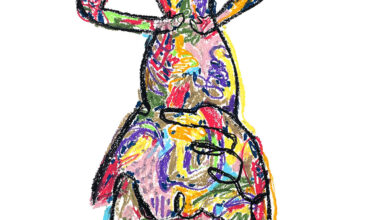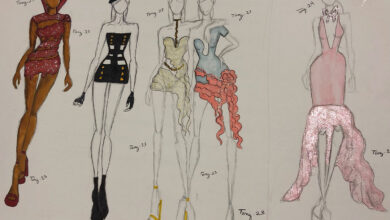The Art of the Book Jacket: Olympia Le-Tan”s special project at last week”s Pitti was inspired by Italian books and films.
Text by Anna Battista
Books tell stories and last week accessories designer Olympia Le-Tan, well-known for her clutches inspired by rare first edition of famous novels, told her own tale to the visitors of her “Sei borsette in cerca d”autore” (Six Bags in Search of an Author) installation at Florence”s Museo Bellini.

Invited by the Pitti organisers to present her work through a special event, Le-Tan turned the refined private museum and gallery owned by a family of antiquarians into a boudoir in which her new collection of bags inspired by Italian books and films was surrounded by images of friends and celebrities taken by American photographer Max Farago, and recreating scenes from iconic Italian movies.

Federico Fellini”s films were celebrated through La dolce vita, La strada and 8 1/2 bags, but also through images of Victoire de Castellane as Anita Ekberg in the Sorelle Fontana-inspired “pretino” dress, and of Jennifer Eymere, editor of Jalouse, as Giulietta Masina in La Strada.

Alberto Moravia”s Il Conformista reappeared as a clutch bag, but also as a picture featuring André Saraiva as Jean-Louis Trintignant in Bertolucci”s film, while Hamish Bowles posed as Helmut Berger in the attire devised by Piero Tosi in Luchino Visconti’s La Caduta degli Dei.
Tilda Swinton starred as stylish Silvana Mangano in Pasolini”s Teorema while Le-Tan herself opted for voluptuous Mangano as the rice worker in Riso Amaro.

Further authors and directors celebrated included Dante, Boccaccio, Machiavelli, Alessandro Manzoni, Luigi Pirandello (whose Six Characters in Search of An Author was also referenced in the title of the installation) and Michelangelo Antonioni with images and bags inspired by Deserto Rosso and L”Avventura.
Famous poses that originally featured Ave Ninchi in Italian comedy La famiglia Passaguai, Sophia Loren in “La Riffa” (an episode from Boccaccio 70), Alida Valli in Senso, and Claudia Cardinale and Alain Delon in Il Gattopardo, were recreated in Farago”s images.
Covers such as the original one for the Collins and Harvill Press edition of The Leopard by German-born Hans Tisdall – a textile design artist who created quite a few book covers for Jonathan Cape characterised by his strong calligraphic lettering – reappered on clutches.
The divertissement, completed by an all Italian soundtrack including Adriano Celentano”s “Chi Non Lavora Non Fa l”Amore” and Gino Paoli”s “Sapore di Sale” among the other tracks, worked well on a superficial level since deep down there was a tangible impression that the event wasn”t about paying tributes to those particular authors, directors, actors and actresses, but it was more about the people in the portraits (ubiquitous Olivier Zahm standing naked in a brave and bold pose wasn”t indeed a convincing representation of the horrors suffered by the victims in Pasolini”s Salò).
Can you tell us more about the bags you made for this project?
Olympia Le-Tan: For this event I made 36 book and mini-book clutches and film inspired bags. The latter come in a round shape, that represents a huge step forward for me, and that calls to mind a film box. As usual, the clasps are in brass and the structure is in thick cotton lined with Liberty fabrics. All the bags are numbered and limited to 16 pieces because I was born on 16th October.
What inspired this collection?
Olympia Le-Tan: I studied Italian while I was at the university and a lot of these books were part of my course. I didn”t read some of them, though I chose the ones to feature in this collection according to which titles I liked and which ones had good covers.
In your opinion, what makes a good cover – the lettering, the colours or the illustrations?
Olympia Le-Tan: There doesn”t have to be a lot of stuff on the cover, in fact I quite like simple and graphic ones.
Did you ever visit Florence before coming for this event?
Olympia Le-Tan: Last time I came to Florence I was 10 years old and in that particular trip I visisted everything because, as kids, my father used to take us to museums all the time. When I came back to select the location for this project I visited the Museum of Natural History, which I really loved, and the French Institute. Then we went to the Bellini Museum and, suddenly, I felt like we were in one of the houses featured in a Visconti film and the venue became an obvious choice.
The bags were accompanied by photographs that call to mind famous scenes from Italian films, what inspired you this installation?
Olympia Le-Tan: I wanted to do something that I never did before, so I asked a lot of people – from my friends to people I liked – to pose recreating scenes from Italian films. I myself posed as Silvana Mangano in Riso Amaro, with shorts and torn stockings, when she was more voluptuous. I tried to mix my collection with the collection in the museum, so as to have an assortment of pictures, bags and art pieces. The photos are a bit like parodies of Italian scenes, they”re more like a joke and I hope guests took them well.
Which are you favourite books and films from this Italian collection?
Olympia Le-Tan: In terms of books probably Alberto Moravia”s Il Conformista; in terms of films, Visconti”s Il gattopardo.
You worked as DJ and sound designer for a while, do you like Italian music?
Olympia Le-Tan: I was a DJ for a long time in various places, from Paris to Japan, but it was more of a past-time rather than a career, it was just because I like music – from The Smiths to girl bands from the “60s – and because I have a big collection of records. I like Italian music and in particular artists such as Mina – who is one of my favourite singers – Celentano, Battisti and so on, and these were also the singers selected as musical background for the event in Florence, together with some soundtracks such as Morricone”s.
A while back you did some clutches inspired by Olympia Press titles, what fascinated you about these books or about their publisher, Maurice Girodias?
Olympia Le-Tan: To be perfectly honest, I discovered Olympia Press after I started doing the bags. When I was searching for covers I found out about this publishing house and now I have a big collection of Olympia Press titles, such as Lolita, Junkie and other William Burroughs books.

Did any publishing house ever contact you for copyright issues?
Olympia Le-Tan: Not yet, but that”s why the clutches are limited. I”m just assuming that if there”s just 16 of each it”s a bit like art objects and I hope they will be flattered as I”m not making a fortune off their backs!
Would you ever sell your clutches together with the book they pay homage to?
Olympia Le-Tan: I thought about that, but the clutches come in a fixed sized, while all books come in different sizes.
Where do you sell your bags?
Olympia Le-Tan: I”m at Colette in Paris, at Open Ceremony in New York and at Browns in London. I”m also online on my own site and Net-a-Porter is selling a capsule collection of my clutches.
You worked at Chanel with Gilles Dufour and also started with him a label, will you ever do clothes?
Olympia Le-Tan: For the next season there will also be some clothes, yet they won”t be inspired by books but by myself. I haven”t thought yet how I will be presenting my clothes, but I”m sure it won”t be through a conventional catwalk show.
Images by Katsuo Mifreki














